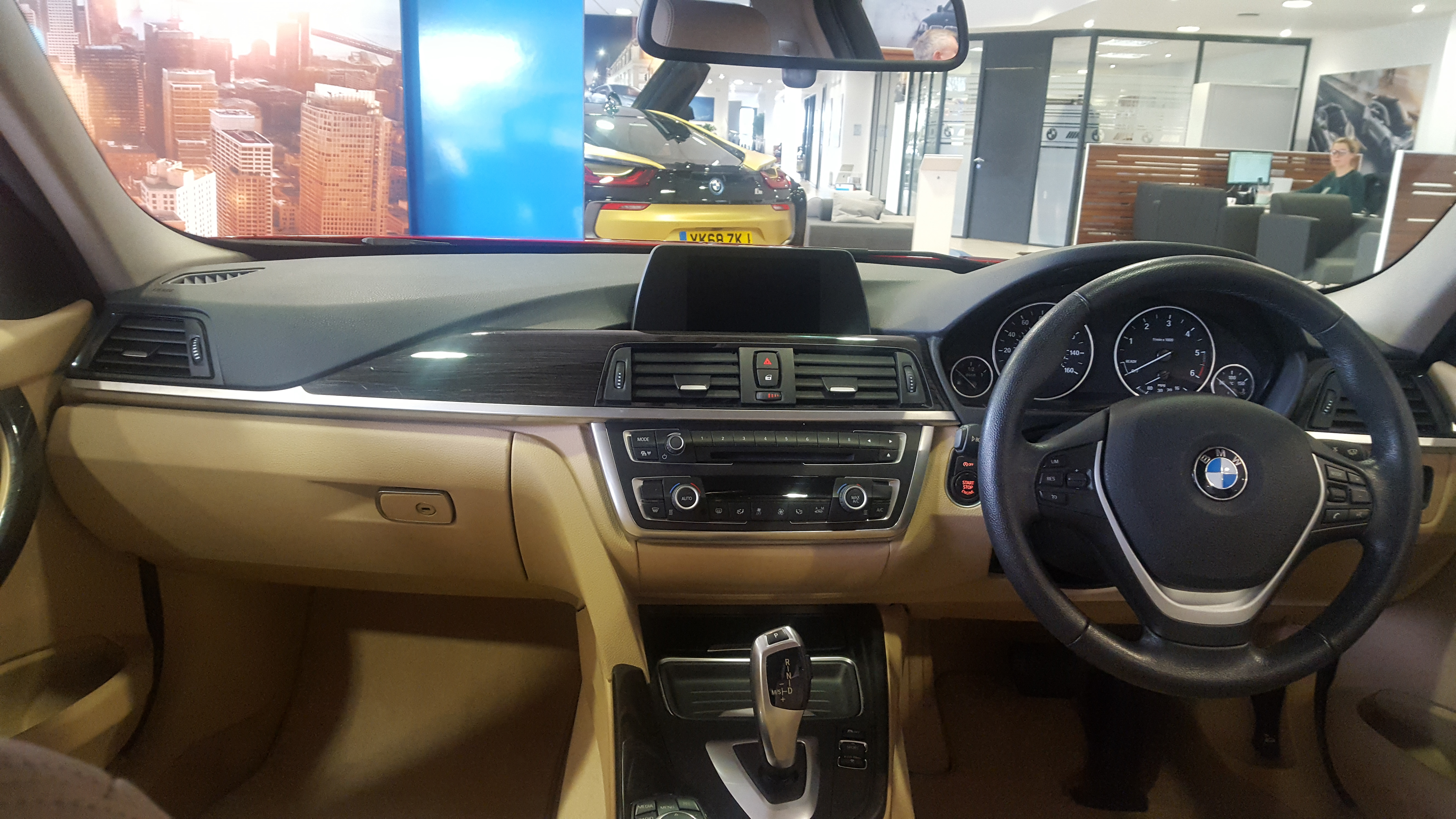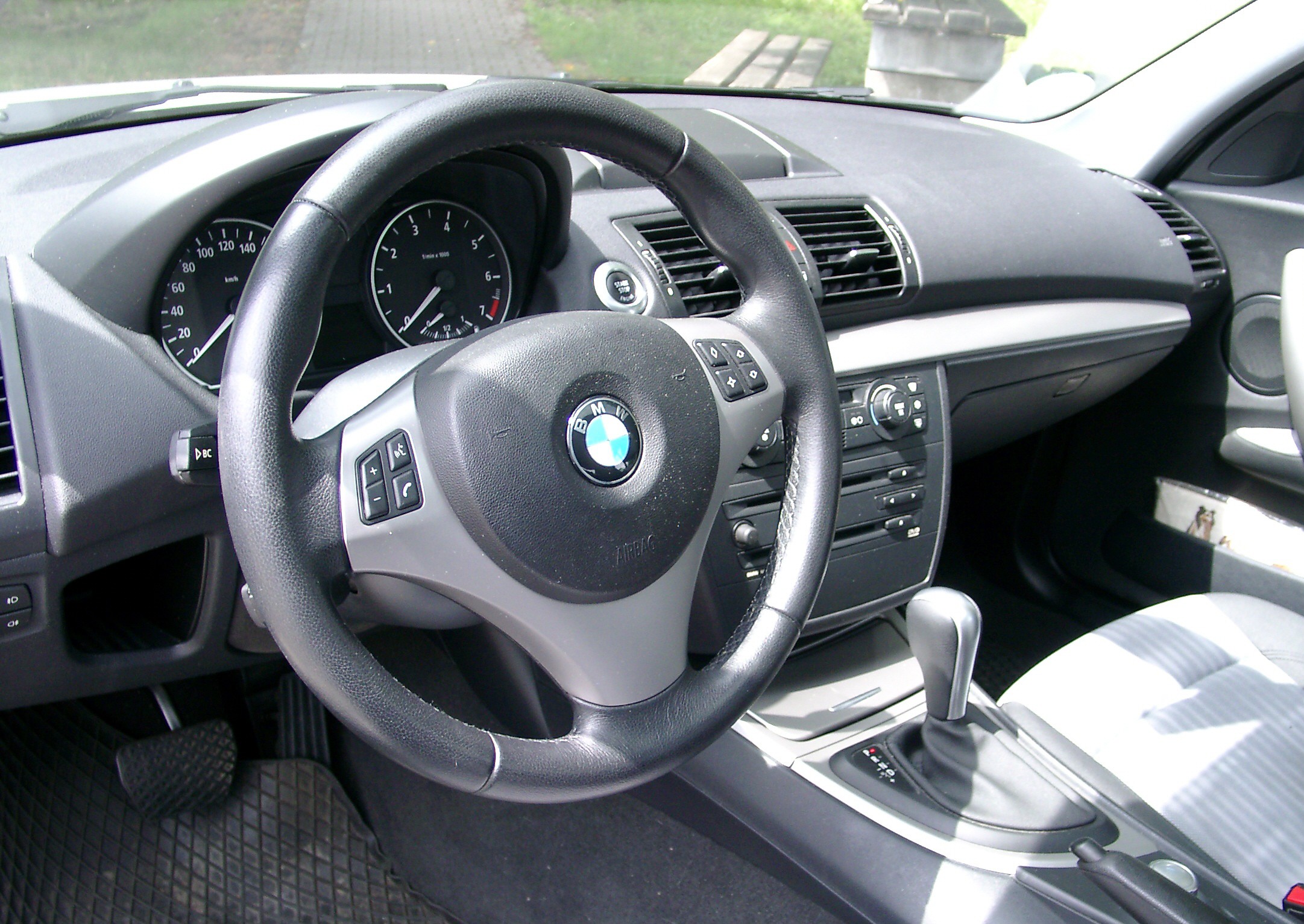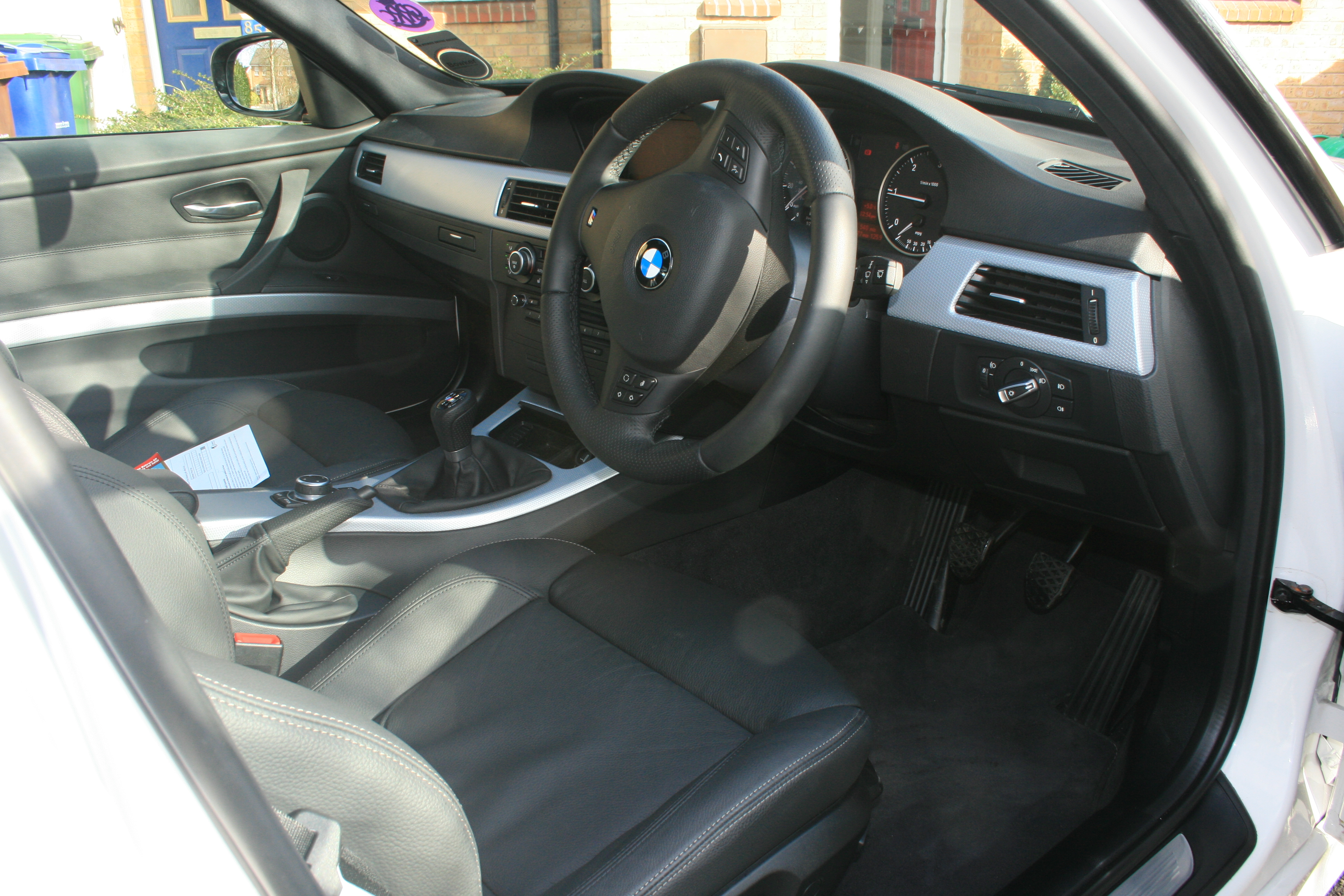|
BMW N55
The BMW N55 is a turbocharged straight-six petrol (gasoline) engine that began production in 2009. The N55 replaced the BMW N54 engine and was introduced in the F07 5 Series Gran Turismo. The N55 was BMW's first straight-six engine to use a twin-scroll turbocharger. It also won three straight Ward's 10 Best Engines awards in 2011–2013. Following the introduction of the BMW B58 engine in 2015, the N55 began to be phased out. The BMW S55 engine is a high performance version of the N55 made by BMW M GmbH, which is used by the F80 M3, F82 M4 and F87 M2 Competition/CS. Design The main differences between the N55 and its N54 predecessor are the use of a single turbocharger, the addition of Valvetronic and the type of fuel injectors. Whilst the N54 used a twin-turbo arrangement, the newer N55 uses only a single twin scroll turbocharger. Valvetronic (variable valve lift) is claimed to improve throttle response, low-rev torque, exhaust emissions and to reduce fuel consumptio ... [...More Info...] [...Related Items...] OR: [Wikipedia] [Google] [Baidu] |
Straight-six Engine
A straight-six engine (also referred to as an inline-six engine; abbreviated I6 or L6) is a piston engine with six cylinders arranged in a straight line along the crankshaft. A straight-six engine has perfect primary and secondary engine balance, resulting in fewer vibrations than other designs of six or fewer cylinders. Until the mid-20th century, the straight-six layout was the most common design for engines with six cylinders. However, V6 engines gradually became more common in the 1970s and by the 2000s, V6 engines had replaced straight-six engines in most light automotive applications. Characteristics In terms of packaging, straight-six engines are almost always narrower than a V6 engine or V8 engine, but longer than straight-four engines, V6s, and most V8s. Compared to V-configuration engines with similar power and displacement, the straight configuration has fewer injectors, a single head, and a single exhaust manifold, all contributing to better reliability and perfor ... [...More Info...] [...Related Items...] OR: [Wikipedia] [Google] [Baidu] |
BMW M2
The BMW M2 is a high-performance version of the BMW 2 Series automobile developed by BMW's motorsport division, BMW M GmbH. As the 2 Series replaced the 1 Series coupé and convertible models, the first-generation M2 was marketed as the most basic M model in the range. The first-generation M2 used the F8x chassis from the M3/M4, codenamed F87 and featured the BMW N55 series engine, while its successors, the M2 Competition and M2 CS, featured a twin-turbocharged engine developed by BMW M GmbH (S55 engine). The second-generation M2 uses the CLAR platform, codenamed G87, which it shares with the G80 M3 and G82 M4. It features the BMW S58 twin-turbocharged inline-six engine, developed by BMW M GmbH. __TOC__ First generation (F87; 2016) BMW M2 Coupé The M2 was unveiled in '' Need for Speed'' in November 2015, before later premiering at the North American International Auto Show in January 2016. Production commenced in October 2015, first delivered early 2016 and the M2 w ... [...More Info...] [...Related Items...] OR: [Wikipedia] [Google] [Baidu] |
BMW E71
The BMW X6 is a mid-size luxury crossover SUV by German automaker BMW. The BMW X6 is the originator of the sports activity coupé (SAC), referencing its sloping rear roof design. It combines the attributes of an SUV (high ground clearance, all-wheel drive and all-weather ability, large wheels and tires) with the stance of a coupé (styling featuring a sloping roof). It is built in BMW's North American plant in Greer, South Carolina alongside the BMW X5, whose platform it shares. Prior to the release of the X7, the X6 was considered a flagship SUV for BMW. The first generation (E71) was released for sale in April 2008 for the 2008 model year, while the second-generation X6 (F16) was launched at the Paris Motor Show in 2014. The third-generation X6 was revealed in July 2019. BMW Concept X6 (2007) The concept model debuted at the 2007 Frankfurt Auto Show and the production X6 officially debuted at the 2008 North American International Auto Show in Detroit and Montreal Intern ... [...More Info...] [...Related Items...] OR: [Wikipedia] [Google] [Baidu] |
BMW 3 Series (F30)
The sixth generation of the BMW 3 Series consists of the BMW F30 (sedan version), BMW F31 (wagon version, marketed as 'Touring') and BMW F34 (fastback version, marketed as 'Gran Turismo') compact executive cars. The F30/F31/F34 generation was produced from October 2011 to 2019 and is often collectively referred to as the F30. For the sixth generation, the coupé and convertible models were spun off to create the new BMW 4 Series nameplate. BMW also introduced a separate hatchback model under the 3 Series nameplate called the 3 Series Gran Turismo (F34), similar to the 5 Series Gran Turismo. The F30 is the first generation of the 3 Series to be powered by a range of turbocharged engines exclusively and electric power steering (replacing the hydraulic power steering systems used previously). The F30 also marked the 3 Series' first use of a three-cylinder engine in its 2015 facelift. A new plug-in hybrid F30 model was also introduced in 2016. A long-wheelbase sedan version (m ... [...More Info...] [...Related Items...] OR: [Wikipedia] [Google] [Baidu] |
BMW X5 (E70)
The BMW E70 is the second-generation BMW X5 mid-size luxury car, luxury crossover SUV. It replaced the BMW X5 (E53) in July 2006. It was manufactured alongside the BMW X6 at BMW's Greer, South Carolina plant in the U.S. and BMW's facility in Toluca, Mexico. Design The E70 BMW X5 was wider, longer; with a longer wheelbase, but remains at the height of the E53 X5 at . Technology The BMW xDrive, xDrive AWD system updates previewed in the facelifted X5 have continued with further detail improvements for the E70. It uses a double wishbone suspension at the front. The manual transmission is entirely dropped, leaving only the automatic transmission. The E70 features many new technological advancements for this class as standard equipment including BMW's iDrive system, electronic 'joystick' gearshift (no mechanical connection to the gearbox to save space in the console), LED taillamps, the first ever all-polypropylene single module fender module, and options such as heads-up display ... [...More Info...] [...Related Items...] OR: [Wikipedia] [Google] [Baidu] |
BMW F25
The BMW X3 is an SUV manufactured by BMW since 2003, based on the BMW 3 Series platform. BMW markets the car as a ''Sports Activity Vehicle'', the company's proprietary descriptor for its X-line luxury vehicles. The first-generation X3 was designed by BMW in conjunction with Magna Steyr of Graz, Austria—who also manufactured all X3s under contract to BMW. BMW manufactured the second-generation X3 at their BMW US Manufacturing Company, Spartanburg plant in South Carolina, United States. Starting with the third generation, BMW South Africa's Rosslyn plant began production of the X3, alongside the Spartanburg plant, after the facility underwent a major upgrade to prepare for the X3 production, replacing the long-running 3 Series production in the plant. About 76,000 units will be manufactured there annually. The car was the first mid-size, premium SUV on the market. In 2008, BMW started competing with the Mercedes-Benz GLK-Class (renamed Mercedes-Benz GLC-Class, GLC-Class since ... [...More Info...] [...Related Items...] OR: [Wikipedia] [Google] [Baidu] |
BMW 1 Series (E87)
The first generation of the BMW 1 Series consists of the BMW E81 (3-door hatchback), BMW E82 (coupe), BMW E87 (5-door hatchback) and BMW E88 (convertible) compact cars. The E81/E82/E87/E88 generation was produced from 2004 until 2013 and is sometimes collectively referred to as the E8x. The E8x replaced the 3 Series Compact as the entry-level models of the BMW range. The chassis has an aluminum multi-link suspension, and a rear-wheel drive layout with a longitudinally-mounted engine giving 50:50 weight balance, which was a rare configuration for a hatchback as most cars in this market segment use front-wheel drive. The engines available were four-cylinder turbo-diesel, four-cylinder naturally aspirated petrol, six-cylinder naturally aspirated petrol and six-cylinder turbocharged petrol (the latter only available on coupe and convertible models). The highest performance trim is the 1 Series M Coupé which was powered by the BMW N54 turbocharged inline-six engine mated to a six ... [...More Info...] [...Related Items...] OR: [Wikipedia] [Google] [Baidu] |
BMW 3 Series (E90)
The fifth generation of the BMW 3 Series range of compact executive cars is designated under the model codes E90 (saloon), E91 (estate, marketed as 'Touring'), E92 (coupé) and E93 (convertible). The model was introduced in December 2004, and produced by BMW until October 2013 and is often collectively referred to as the E90, E9x, or occasionally, the E92. The E92 335i was the first 3 Series model produced with a turbocharged petrol engine. It was also the first 3 Series to include the iDrive operating system, which consists of navigation, infotainment and essential vehicle functions. The E9x saw the introduction of run-flat tyres to the 3 Series range. Models with run-flat tires are not equipped with a spare tyre. The E90/E92/E93 M3 is the only generation of M3 to be powered by a V8 engine. Introduced in 2007, it uses the BMW S65 naturally aspirated V8 engine and was produced in saloon, coupé and convertible body styles. Following the introduction of the F30/F31 3 Serie ... [...More Info...] [...Related Items...] OR: [Wikipedia] [Google] [Baidu] |
BMW 5 Series (F10)
The sixth generation of the BMW 5 Series consists of the BMW F10 (saloon version), F18 (long-wheelbase saloon), BMW F11 (wagon, marketed as ''Touring'') and BMW F07 (fastback/hatchback, marketed as ''Gran Turismo'') executive cars and were produced by BMW from January 2010 (for the 2011 model year) to 2017, with F10 being launched on 20 March 2010 to domestic market and F11 in the summer of 2010. The F07 Gran Turismo was produced from early September 2009 to 2017, being launched in the domestic German market in late October 2009. The F10 5 Series shares a platform with the F01 7 Series full-size luxury saloon and the F12 6 Series executive-sized grand tourers. The F10 generation is the first 5 Series to offer a hybrid drivetrain, a turbocharged V8 engine, an 8-speed automatic transmission, a dual-clutch transmission (in the M5), active rear-wheel steering (called "Integral Active Steering"), electric power steering, double-wishbone front suspension, an LCD instrument clus ... [...More Info...] [...Related Items...] OR: [Wikipedia] [Google] [Baidu] |
Stroke (engine)
In the context of an internal combustion engine, the term stroke has the following related meanings: * A phase of the engine's cycle (e.g. compression stroke, exhaust stroke), during which the piston travels from top to bottom or vice versa. * The type of power cycle used by a piston engine (e.g. two-stroke engine, four-stroke engine). * "Stroke length", the distance travelled by the piston during each cycle. The stroke length, along with bore diameter, determines the engine's displacement. Phases in the power cycle Commonly used engine phases or strokes (i.e. those used in a four-stroke engine) are described below. Other types of engines can have very different phases. Induction-intake stroke The induction stroke is the first phase in a four-stroke (e.g. Otto cycle or Diesel cycle) engine. It involves the downward movement of the piston, creating a partial vacuum that draws an air-fuel mixture (or air alone, in the case of a direct injection engine) into the combustion ... [...More Info...] [...Related Items...] OR: [Wikipedia] [Google] [Baidu] |
Bore (engine)
In a piston engine, the bore (or cylinder bore) is the diameter of each cylinder. Engine displacement is calculated based on bore, stroke length and the number of cylinders: displacement = The stroke ratio, determined by dividing the bore by the stroke, traditionally indicated whether an engine was designed for power at high engine speeds ( rpm) or torque at lower engine speeds. The term "bore" can also be applied to the bore of a locomotive cylinder or steam engine pistons. In steam locomotives The term bore also applies to the cylinder of a steam locomotive or steam engine. Bore pitch Bore pitch is the distance between the centerline of a cylinder bore to the centerline of the next cylinder bore adjacent to it in an internal combustion engine. It's also referred to as the "mean cylinder width", "bore spacing", "bore center distance" and "cylinder spacing". The bore pitch is always larger than the inside diameter of the cylinder (the bore and piston diameter) sinc ... [...More Info...] [...Related Items...] OR: [Wikipedia] [Google] [Baidu] |
Compression Ratio
The compression ratio is the ratio between the maximum and minimum volume during the compression stage of the power cycle in a piston or Wankel engine. A fundamental specification for such engines, it can be measured in two different ways. The simpler way is the static compression ratio: in a reciprocating engine, this is the ratio of the volume of the cylinder when the piston is at the bottom of its stroke to that volume when the piston is at the top of its stroke. The dynamic compression ratio is a more advanced calculation which also takes into account gases entering and exiting the cylinder during the compression phase. Effect and typical ratios A high compression ratio is desirable because it allows an engine to extract more mechanical energy from a given mass of air–fuel mixture due to its higher thermal efficiency. This occurs because internal combustion engines are heat engines, and higher compression ratios permit the same combustion temperature to be reached wit ... [...More Info...] [...Related Items...] OR: [Wikipedia] [Google] [Baidu] |






